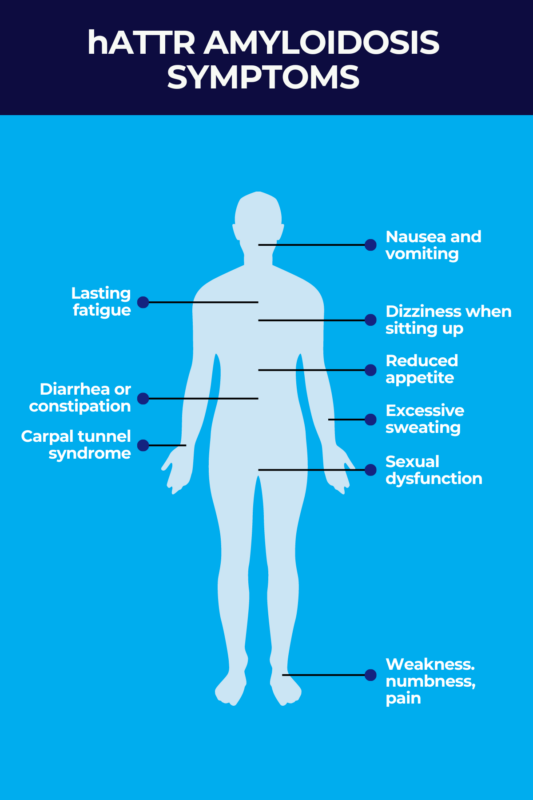Detecting the early signs and symptoms of hATTR amyloidosis
Last updated March 14, 2024, by Marisa Wexler, MS

Hereditary transthyretin amyloidosis, also called hATTR amyloidosis or ATTRv amyloidosis, is a rare genetic disorder caused mainly by mutations in the TTR gene. These mutations cause the protein transthyretin to form toxic clumps, which can then lead to damage to the body’s tissues and organs, including to the nerves and heart.
When there is nerve damage from the disease, it is sometimes referred to as familial amyloid polyneuropathy (FAP).
Tests to confirm a diagnosis of hATTR amyloidosis are fairly straightforward through genetic testing and tissue biopsy. However, because it is a rare disease, symptoms that vary greatly from person to person and are often nonspecific, it can be difficult to diagnose, especially in people who don’t have a family history.
It’s not unusual for it to take several years to get an accurate diagnosis. Misdiagnoses are also common.
Early symptoms of hATTR amyloidosis
Early signs and symptoms of hATTR amyloidosis include:
- Weakness and changes in sensation such as pain or numbness, especially in the feet, which can cause difficulty walking
- Carpal tunnel syndrome in the wrists
- Sexual dysfunction, an inability to empty the bladder, or recurrent urinary tract infections
- Sweating abnormally
- Orthostatic hypotension (a drop in blood pressure upon rising)
- Diarrhea or constipation, which can occur frequently or alternate
- Nausea and vomiting
- Decreased appetite and unexplained weight loss
- Lasting fatigue.
Peter Gorevic, MD, is a professor emeritus of medicine with a specialty in rheumatology at the Icahn School of Medicine at Mount Sinai in New York City. He says he sees patients who come in with musculoskeletal issues that turn out to be amyloidosis.
“One of the major ones we’re seeing is carpal tunnel syndrome,” he says.

How does hATTR amyloidosis affect the body?
In hATTR amyloidosis, the transthyretin protein forms toxic clumps called amyloid fibrils, which damage the body’s tissues. The disease usually affects the nerves and/or heart. It also can affect other systems.
Nerve damage
hATTR amyloidosis frequently involves widespread damage to the nerves that run throughout the body, a condition referred to as polyneuropathy (“poly” meaning “many” and “neuropathy” meaning “nerve damage”). The disease mainly affects two kinds of nerves: sensorimotor nerves and autonomic nerves.
Sensorimotor nerves are responsible for controlling movements and detecting sensations such as pain or itching. hATTR amyloidosis typically causes sensorimotor neuropathy, usually first damaging the longest nerves that stretch all the way down to the feet. It is why symptoms such as pain and numbness usually appear in the feet first.
Autonomic nerves are responsible for controlling unconscious bodily processes, such as breathing, digestion, and sweating. Damage to these nerves, referred to as autonomic neuropathy, can lead to problems like gastrointestinal symptoms, sexual dysfunction, and orthostatic hypotension.
“Autonomic neuropathy presents in a lot of different ways,” Gorevic says. “It has a lot to do with gastrointestinal symptoms, which may be directly because the bowel is not moving properly. A lot of the men complain of erectile dysfunction.”
Heart damage
Cardiomyopathy, a type of muscle damage that makes it harder for the heart to pump blood, is another common sign of hATTR amyloidosis. Heart damage from the disease generally doesn’t cause noticeable symptoms early on, though issues like abnormal heart rhythms may be detected by medical tests in early stages.
Over time, hATTR-related cardiomyopathy can cause heart failure, when the heart isn’t able to adequately pump blood through the body.
Other affected organs
Less common signs of hATTR amyloidosis include problems with the kidneys and with the eyes. These include blurred vision and vitreous opacity — a buildup in the gel of the eye causes a nonexistent object to appear to “float” in a person’s field of vision.
How is hATTR amyloidosis diagnosed?
The gold standard for diagnosing hATTR is genetic sequencing of the TTR gene to look for disease-causing TTR gene mutations. This can definitively diagnose the condition in patients who have symptoms and also can identify patients who have not yet developed signs of the disease.
A diagnosis of hATTR amyloidosis can be confirmed via a biopsy, in which a small piece of tissue from an affected area is collected and analyzed for signs of toxic TTR protein clumps. While a biopsy can diagnose hATTR amyloidosis, it also is possible to have a false negative result due to the protein clumps not being evenly distributed throughout the body’s tissues.
Additional assessments, such as measurements of sensory-motor nerve function, autonomic nerve tests, and heart health checks, can also help identify the degree of disease involvement and classify stages of hATTR amyloidosis.
Though the tests used in an hATTR amyloidosis diagnosis are fairly straightforward, diagnosing the condition is often a challenge because its symptoms are often nonspecific. It can make it hard for clinicians to rule out other potential explanations and narrow it down to hATTR amyloidosis.
Confirming a diagnosis is usually more straightforward for those who have a family history of hATTR amyloidosis since they are already known to be at risk of having the disease.
For people without a known family history, it often takes years to receive an accurate diagnosis. People have frequently been misdiagnosed with other disorders that cause similar symptoms, such as inflammation in the spinal cord or lumbar stenosis (when nerves in the lower spinal cord become pinched).
Though the diagnostic odyssey can be very frustrating, recent changes are slowly helping to make a difference: Increased hATTR amyloidosis awareness among clinicians, as well as more widespread access to genetic testing, are expected to substantially reduce the time it takes to get a diagnosis in the future.
“Misdiagnosis is common, and I am often contacted by desperate sufferers who believe they have a disease, but doctors refuse to listen,” says caregiver Jaime Christmas in one of her columns on FAP News Today. “It helps when doctors are not quick to dismiss what the patient is going through.”
Disease progression and management
hATTR amyloidosis is a progressive disorder, which means it generally worsens over time. Because it typically affects multiple parts of the body, treatment often requires multidisciplinary care from a team of specialists who can help address specific disease symptoms.
While there isn’t a therapy that can reverse the damage from hATTR amyloidosis, several treatments are available that can help slow its progression.
Starting treatment as early as possible is key for minimizing the impact of the disease and managing hATTR amyloidosis symptoms. Physical therapy, which aims to maximize the body’s functional capacity, and occupational therapy, which helps to come up with strategies for daily life, also can be beneficial.
Treatments to slow progression of hATTR amyloidosis are available, though in some countries, including the U.S., medications are only available specifically for people who have nerve damage or heart damage from the disease.
FAP News Today is strictly a news and information website about the disease. It does not provide medical advice, diagnosis, or treatment. This content is not intended to be a substitute for professional medical advice, diagnosis, or treatment. Always seek the advice of your physician or other qualified health provider with any questions you may have regarding a medical condition. Never disregard professional medical advice or delay in seeking it because of something you have read on this website.
Recent Posts
- Our role as patient advocates is vital, but funding remains an issue
- Gene therapy study placed on hold after elderly man passes away
- Liver damage pauses nex-z gene therapy trials
- Treatment switches in FAP are common, reasons numerous: Study
- Phase 3 trial is tracking use of acoramidis to block ATTR onset
Related articles





